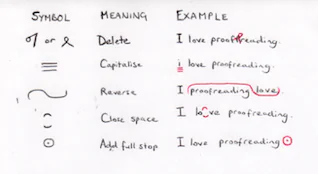
Shortcuts and Time-Savers to Avoid
Proofreading can be a painstaking process. And when there’s a deadline looming or a frazzled client on your back, it’s very tempting to look for shortcuts. Some of these shortcuts are legitimate time-saving tips that proofreaders should learn to improve their efficiency.
But some have no place in proofreading at all. And in this post, we’re going to look at a few temptations you should probably avoid, including an array of functions in Microsoft Word and the dastardly temptation of proofreading software.
The Speed of Modern Proofreading
First, though, let’s take a moment to appreciate how much simpler editing has become. As methods of publishing developed, so have methods of proofreading. Our fore-editors used editors’ marks on hard copies, which made them look super esoteric and clever.

It was not, however, an especially efficient process. The corrections would be used to create a new version of the document, which would then need to be printed again.
Today, as a proofreader, you would be unlikely to use proofreaders marks in your work. There may be some clients who prefer it (e.g. those who do not get on well with or have access to technology), but most of your editing will be done on a computer.
Word processors like Microsoft Word allow you to quickly and easily track changes while editing, but they also make it simple to create a ‘clean’ copy with no markup. This means clients can see the changes you made, but they also have a copy that is ready to use.
Frenemies: When Time-Savers Go Wrong
A frenemy is (in case you didn’t know) part friend, part enemy. And proofreaders have such ambiguous relationships with some of the features offered by Microsoft Word. Let’s start with our old friend, spellcheck: which can get you into trouble if you depend upon it too much.
Spellcheck can pick up typos. It is particularly useful when employed after proofreading, when it can highlight any introduced errors such as missing spaces. However, it is not a replacement for proofreading and a computer cannot be trusted to get everything right.
The find and replace function can also be friend or foe. It can be used to find and remove repeated errors in a document. But it should be used carefully. For instance, say a client regularly spells rhyme as rime. It might be tempting to skip straight to Replace All and correct every instance of rime at once, which would save time. But then any word that contains the letters r-i-m-e will also be changed. And that would be a crhyme.
Finally, the thesaurus function may be useful if you need a quick alternative to an overused term. However, it should be used with caution. Synonyms won’t work in every situation. Take the word row, for instance: it can be a line (e.g. a row of houses) or a fight (e.g. a blazing row). And if you use the thesaurus in Microsoft Word, the suggestions won’t take account of this ambiguity, so you could pick the wrong word for the sentence at hand.
Shortcuts to Chaos: Proofreading Software
There aren’t many shortcuts that are all bad. However, there are a couple.
Don’t rely on proofreading software. Please, please don’t. While, like Word’s spellcheck, it can be useful, as a proofreader you are being paid to cast a human eye over people’s writing. Don’t sell your clients short by passing your work on to a piece of software.
Such software focuses solely on spelling, grammar, and punctuation. But good proofreading requires you to be mindful of the sense of what you’re reading. Ignoring this in a document can lead to mistakes being added and meanings being changed.
Become A Proofreader
If you’d like to learn more about the ins and outs of freelance proofreading, sign up to our Becoming A Proofreader course today or take a look at our free trial.


